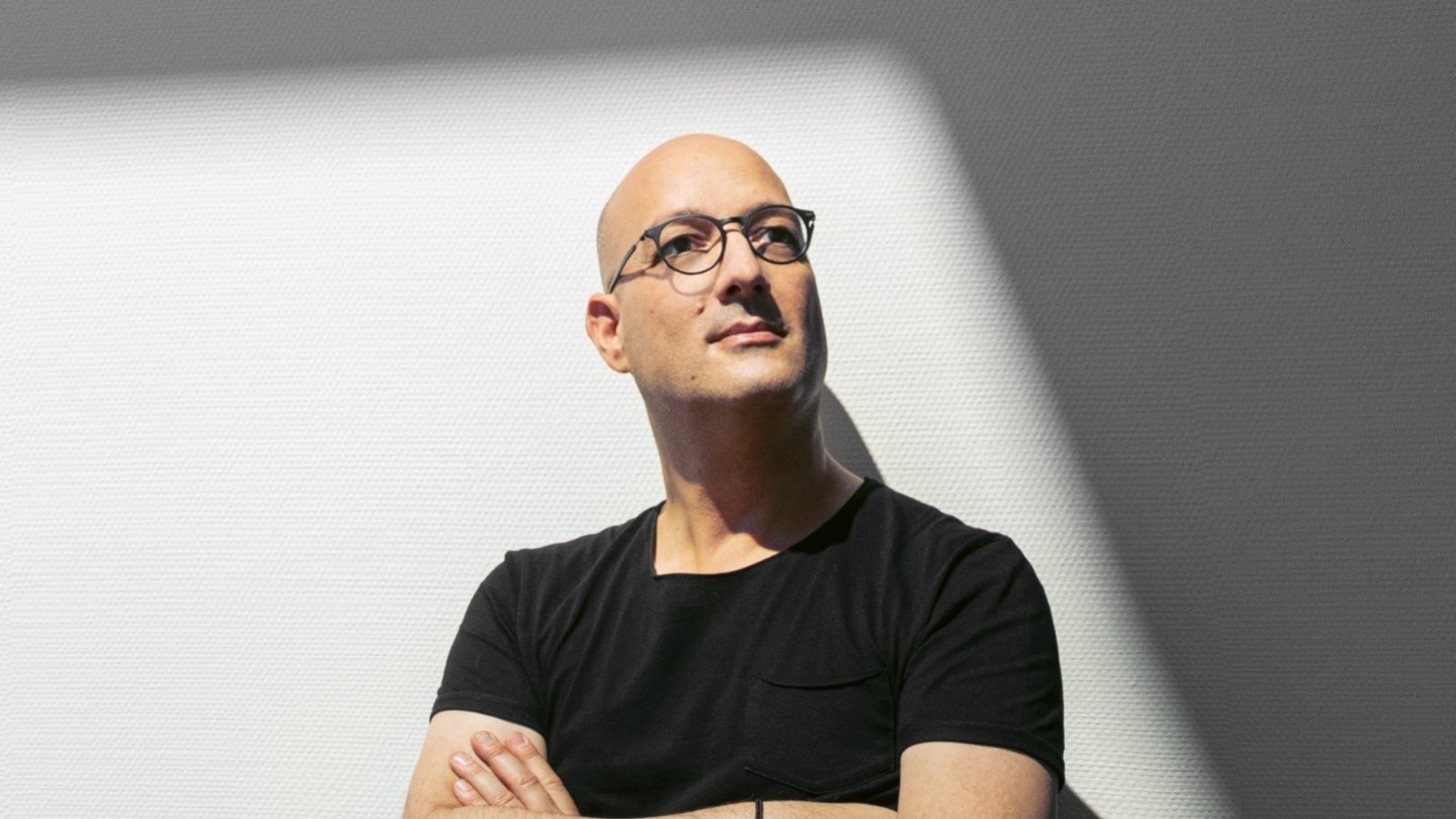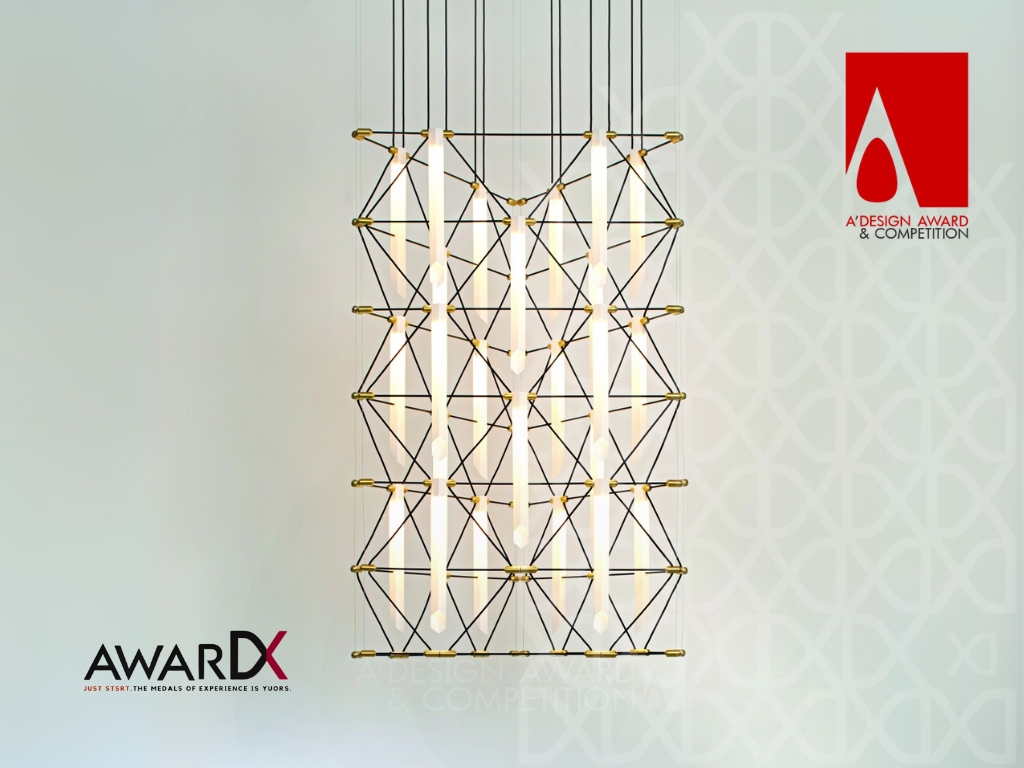Davide Oppizzi is a Swiss–Italian designer known for work that sits at the intersection of material experimentation and spatial thinking. His Mozaik System — conceived as a modular, architectural lighting collection — is a standout example of how a single idea (repeatable, textile-wrapped elements) can translate into multiple product types: pendant lamps, chandeliers, and large modular panels that function as luminous room dividers. The project earned the Platinum A’ Design Award, an indicator that the jury regarded Mozaik as exceptional in both concept and execution.

What the Mozaik System Is
Mozaik is a lighting system built from a simple, repeatable element: a vertical tube consisting of a cable wrapped in fabric, separated by a thin fiberglass rod and held together by brass connectors. Each vertical element houses a low-voltage feed that powers a small LED source, which is covered by a hexagonal fabric diffuser. By combining hundreds of these elements into ordered arrays, the system produces continuous luminous surfaces that read as both light objects and spatial membranes. Versions range from single pendant units to larger panels (for example, 1×5, 2×5 and 5×5 configurations) and chandeliers assembled into geometric compositions.
Design Language and Inspirations
The visual language of Mozaik references mosaic geometry and the effect of a rain of points of light. Oppizzi framed the collection to be architectural — to structure interior volumes rather than merely provide local illumination. The vertical rhythm of the tubes creates a tactile surface of light: from a distance Mozaik reads as a luminous plane; up close it reveals texture, color choice and careful detailing. Designers often describe the result as a luminous curtain that both defines and mediates a space.
Materials, Mechanics and Light Technology
Mozaik’s technical intelligence lies in the way material and simple mechanics produce a refined outcome. Key material and engineering points include:
Textile-wrapped vertical tubes that enable a wide palette of colors and textures.
Fiberglass rods that keep vertical spacing consistent while maintaining low weight.
Brass connectors that function structurally and as electrical contacts, delivering low-voltage power to each LED element.
Hexagonal fabric diffusers that soften the LED output and create an even, mosaic-like glow.
The system uses LED sources for efficiency and longevity. Because the elements are modular and replaceable, maintenance is straightforward and the product can be reconfigured or repaired without discarding large components.
Modularity: From Pendant to Space Divider
One of Mozaik’s strategic strengths is modularity. Architects and interior designers can deploy the system as a single pendant to mark a table, as a chandelier cluster for volumetric drama, or as a full wall/ceiling panel that separates circulation from program. This adaptability makes Mozaik attractive to hospitality projects (lobbies, restaurants, bars), corporate interiors (reception zones, breakout areas), and residential projects that seek an elevated, tactile lighting identity.
Why the Platinum A’ Design Award Matters
The Platinum A’ Design Award is the highest-tier recognition within the A’ Design Award framework. That distinction signals that the jurors found Mozaik to be not just well executed but leading in terms of creativity, innovation and field impact. For a product like Mozaik, Platinum recognition amplifies visibility among specifiers, architects and trade press — it’s an important credibility multiplier for both the designer and the manufacturer.
Applications and Impact in Interiors
Mozaik performs on several levels within an interior:
Visual identity: As a sculptural element, it becomes an instant signature of a room.
Acoustic and visual screening: Large arrays act as partial visual dividers and can soften sound when textiles are chosen for absorption.
Zoning: By hanging panels strategically, architects can delineate seating clusters and circulation without heavy construction.
Night identity: Perimeter LED detailing and the continuous surface transform the night silhouette of a space, giving hospitality venues a memorable evening presence.
These combined effects mean Mozaik adds both functional value and a measurable experiential uplift to projects.
Customization, Production and Specification
The Mozaik System is offered in multiple configurations and a wide selection of fabric finishes, enabling clients to match brand palettes and programmatic needs. The manufacturer supplies configurable modules so that installers can compose bespoke panels on site or choose pre-configured arrays. The product’s design anticipates professional installation and integrates with standard electrical systems using low-voltage drivers and accessible connection points.
Sustainability and Lifecycle Considerations
Mozaik’s modularity supports longer lifecycles: individual tubes, diffusers and LEDs can be replaced instead of discarding entire fixtures. Choosing durable textiles and recyclable metals for connectors also helps reduce environmental impact. Additionally, the energy efficiency of LEDs and the ability to zone lighting contribute to operational savings in commercial settings.
Commercial Value and Why Brands Should Consider Mozaik
For manufacturers and interior brands, Mozaik is attractive because it provides:
A distinctive product family that supports multiple price tiers (single pendants to large architectural panels).
High specification appeal for boutique hotels, fine dining and brand stores that require a unique lighting identity.
Marketing leverage — award recognition like Platinum A’ Design Award accelerates PR and trade interest.
Cross-sell potential — the collection can anchor wider product stories (textiles, finishes, custom colorways).
For specifiers, Mozaik reduces the creative gap between concept and reality: a designer sketch can be realized with repeatable modules that still feel bespoke.
Curatorial and Editorial Opportunities
Mozaik’s visual and technical story lends itself well to editorial features, showroom installations and trade-fair demonstrations. When staged in photography or film, panels and arrays produce compelling images: strong vertical rhythm, soft glow and a tactile sense of material. These visuals perform well across social channels, PR spreads and showroom displays, providing ongoing content for design houses and manufacturers.
Official links for further reading:
- https://competition.adesignaward.com/ada-winner-design.php?ID=64196
- https://competition.adesignaward.com/gooddesign.php?ID=64196
- https://www.designheure.com/en/designers/davide-oppizzi/
- https://www.archiproducts.com/en/products/designheure/led-pendant-lamp-mozaik-pendant-lamp_373902
- https://dcube.swiss/templates_popup/page_standard.php?lan=en&objetID=604&rubID=2
- https://www.archiexpo.com/prod/designheure/product-67917-2046487.html



